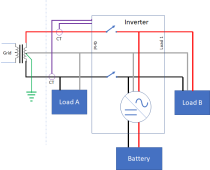I am asking about Load 1 not Load 2. When the inverter is supplying power to Load A and Load B at the same time, is Load B getting grid tie inverter power
It depends.
If the battery is dead and the inverter is not putting power on the line, all of the power for Load A & B is going to be coming from the utility.
If the inverter is putting out enough power for all of Load A & B, all of the power will come from the inverter and none from the grid.
If Load A & B needs more power than what the inverter can supply, some of the power will come from the utility and some from the inverter.
I know I started it, but talking about where the power is coming from for each load when both the grid and the inverter are supplying power is probably not a good way to think about it. Perhaps a super simplified diagram of the system would help.

The inverter and the utility are two power sources in parallel. Both can put power into the circuit. Some of the power will go to Load A and some of the power will go to Load B. It does not really matter which power is going where. The grid and Inverter are supplying power and the two loads are taking power.
If the inverter is providing more power than the combined load of both A and B, the inverter output voltage will be slightly higher than the utility voltage and power will be pushed/exported to the grid. (The grid becomes a load that is taking the excess power)
If the inverter is providing less power than the combined load of both A & B, then the voltage from the grid will be slightly higher and power will be purchased from the grid to make up the difference between what the inverter can supply and the combined demand of A & B.
Edit: Added
clarity
With the current transformers, the inverter can adjust its voltage
so that the voltage at the service entrance exactly matches the grid voltage. This allows the inverter to power both A & B without exporting or importing power to/from the Utility.
If the Inverter is charging the batteries from the grid, It becomes a load and everything is powered by the utility.
When the utility power goes down, the relays open up and everything changes.

Since Load A is disconnected from the inverter and the Utility is down.... Nothing is powering Load A.
Load B is still connected to the inverter so the inverter can power it for as long as battery power is available.




